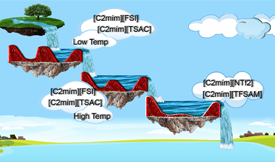
Tuning the Miscibility of Water in Imide-Based Ionic Liquids
A.S.L. Gouveia, C.E.S. Bernardes, A.S. Shaplov, E.I. Lozinskaya, J.N.C. Lopes, I.M. Marrucho
Phys. Chem. Chem. Phys. 2020, 22, 25236-25242.
Abstract
Liquid–liquid phase behavior measurements were performed for binary mixtures of water and ionic liquids (ILs) containing the same 1-ethyl-3-methylimidazolium ([C2mim]+) cation and different imidebased anions, having symmetric (bis(fluorosulfonyl)imide ([FSI])) or asymmetric structures (2,2,2-trifluoromethylsulfonyl-N-cyanoamide ([TFSAM]) and 2,2,2-trifluoro-N-(trifluoromethylsulfonyl)acetamide ([TSAC])). An inversion of phase behavior was observed: while below B298 K, the miscibility of water in the studied ILs increases according to the order [C2mim][TSAC] o [C2mim][FSI] o [C2mim][NTf2], for temperatures above B303 K, the reverse trend is observed [C2mim][NTf2] o [C2mim][FSI] o [C2mim][TSAC]. In turn, above B306 K the [C2mim][TFSAM] is completely miscible with H2O in all ranges of concentrations. The obtained results also revealed an unusual water solubility variation of 11% in [C2mim][FSI], and 20% in [C2mim][TSAC], when the system temperature was changed by less than 1 K, around 298 K and 301 K, respectively. Molecular Dynamics (MD) simulations were used to understand the IL–water interactions and rationalize the experimental observations. These results suggested that the miscibility trends are mainly related to the ability of the water molecules to form water–anion and water–water aggregates in solution.
Return Previous Next